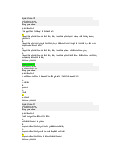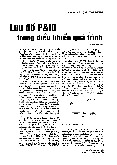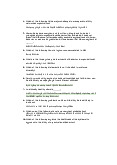



Preview text:
MKT _ REVISION C7-8-9-10 CHAP 7:
1. Lengthening a product line beyond its current range is referred to as product line ________. a. filling b. stretching c. strengthening d. mixing
2. ________ products are consumer products and services that
customers usually buy frequently, immediately, and with
minimal comparison and buying effort. a. Convenience b. Unsought c. Specialty d. Capital
3. Which of the following terms best describes the process of
designing and producing a container or wrapper for a product? a. labeling b. packaging c. licensing d. positioning
4. Which of the following is an example of an unsought product? a. laundry detergent b. life insurance c. toothpaste d. refrigerator
5. ________ refer to a form of product that consists of activities,
benefits, or satisfactions offered for sale that are essentially intangible. a. Services b. Pure products c. Line extensions d. Co-brands CHAP 9:
1. Each PC produced by HP involves a cost of computer chips,
wires, plastic, packaging, and other inputs. Although these costs
tend to be the same for each unit produced, they are called
________ costs because the total changes based on the number of units produced. a. variable b. target c. fixed d. payroll
2. ________ uses buyers' perceptions of what a product is worth as the key to pricing. a. Target return pricing b. Cost-plus pricing
c. Customer value-based pricing d. Psychological pricing
3. Computer World sells laptops separately from accessory
products like docking stations, anti-virus software, and external
hard drives. This is referred to as ________ pricing. a. by-product b. product bundle c. market-penetration d. optional – product
4. Which of the following sets the upper limit for a product's pricing?
a. consumer perceptions of value b. competition c. profits d. product costs
5. Rent, electricity, and executive salaries that do not vary with
production or sales level are referred to as ________ costs. a. variable b. target c. fixed d. break-even CHAP 10:
1. Producers use marketing intermediaries because they ________.
a. create greater efficiency in making goods available to target markets.
b. supply inexpensive raw materials for manufacturing products.
c. provide technical expertise for faster production.
d. monitor day-to-day activities during production.
2. Vertical conflicts in distribution channels are conflicts that occur between ________. a. different le
vels of the same channel
b. different levels of different channels
c. same levels of different channels
d. same levels in the same channel
3. When Toyota announces a product recall on its Camry model
due to a faulty igniter, they are using ________ to coordinate with dealers and car owners. a. inbound logistics b. outbound logistics c. reverse logistics d. inventory logistics
4. A firm that uses direct marketing would most likely sell its products through ________. a. large wholesalers b. multiple intermediaries c. big box retailers d. the company Web site
5. Which of the following would be considered an upstream
partner in a company's supply chain?
a. a firm that resells a finished product and shares the net sales with the producer.
b. a firm that buys products at wholesale cost from the company
c. a firm that markets a product to consumers through social media
d. a firm that provides technical expertise in the production of a product




